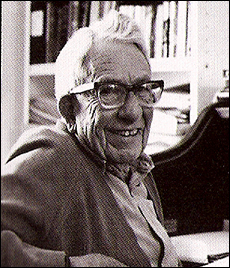Santa Fe Living Treasures – Elder Stories
<<Back to Treasures Index John ManleyINFLUENCING THE COURSE OF HISTORYHonored March 1987 | John ManleyYou may ask how a scientist who helped build the bomb can claim to be working for peace. The answer is simple. We were at war at the time, and I was working for peace in my way. Now that the war is over and we face another kind of nuclear threat, I've been working for peace in another way," said John Manley. Handpicked by J. Robert Oppenheimer to coordinate the experimental aspects of atomic weapons development, John was "very doubtful about it, but finally agreed to do it on a trial basis." On April 4, 1943, John cautiously made his way up the primitive road to Los Alamos, carrying the fragile tube of a Cockroft-Walton accelerator in the back of a pickup. His initial tasks were to oversee the construction of laboratory buildings he had approved from Chicago "without having any knowledge of the terrain," and to install the accelerator. "I didn't even know there was such a profession when I was in high school," he said, when asked why he became a physicist. "I went into electrical engineering. After a couple of years I found engineering was far too much cookbook stuff and learning how things were made but not why. My interest was in why." Born to Benjamin and Effie Manley in 1907, John grew up an only child in Harvard, Illinois. "My family never had very much money," he recalled. "My father painfully worked his way through law school." John completed grade school and high school in Harvard, and earned a state fellowship at the University of Illinois. John graduated in 1929 and accepted a tutoring job in Vienna for the winter. He returned to a fellowship at Westinghouse and received a doctorate in physics from the University of Michigan in 1934. John met Kathleen Baird in New York when both were teaching at Columbia University. They married in 1935 and became parents to two daughters, Kathleen and Kim. Please see Volume 1 for complete text. |
